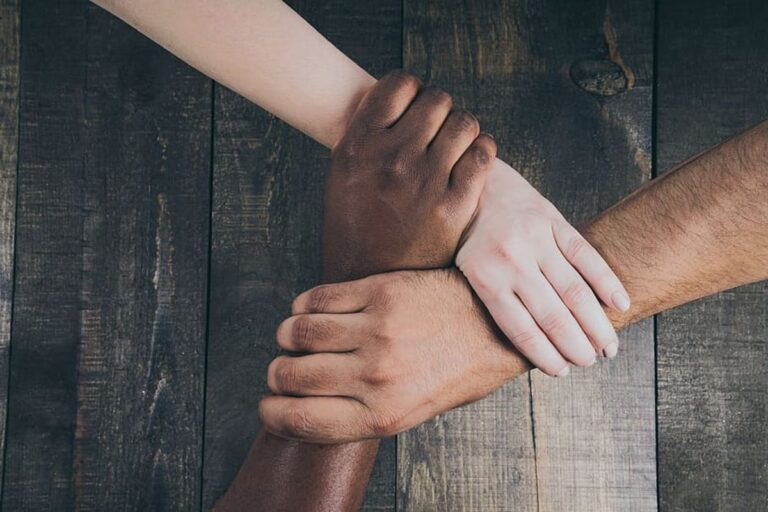Sexual Fluidity and Identity in Polyamorous Relationships
The exploration of sexual fluidity and identity within polyamorous relationships is a multifaceted journey that delves into the diverse spectrum of sexual orientations, relationship structures, emotional connections, and personal growth. This article aims to shed light on the complexities and nuances of polyamory, offering insights into how individuals navigate their sexual identities and form meaningful bonds in non-monogamous dynamics.
Key Takeaways
- Sexual fluidity in polyamorous relationships allows individuals to explore a wide range of sexual identities, including bisexuality, bi-curiosity, and bi-situational experiences.
- Polyamorous relationship structures vary greatly, from hierarchical arrangements to independent connections like parallel polyamory, each with its own set of dynamics and rules.
- Intimacy in polyamory goes beyond physical interactions, emphasizing the importance of emotional bonds, intentional intimacy, and understanding each partner’s erotic blueprint.
- Compersion, characterized by empathetic joy in a partner’s happiness with others, is a central emotional concept in polyamory that can signify relationship success and unity.
- The polyamorous landscape is continually evolving, influenced by personal growth, external factors such as the pandemic, and the flexibility to adapt relationship dynamics over time.
The Spectrum of Sexual Identity in Polyamory

Understanding Bisexuality and Fluidity
Sexual fluidity challenges the traditional binary view of sexual orientation, suggesting that sexuality can evolve over time and be influenced by a variety of factors. This concept acknowledges that individuals may not fit neatly into categories like heterosexual or bisexual, but rather, experience a spectrum of attractions that can shift and change.
- Sexual fluidity: Embracing curiosity and openness to new experiences.
- Sexual orientation: A spectrum rather than fixed categories.
- Sexuality: Influenced by a range of factors, not just gender.
- Gender and gender identity: Integral to understanding sexual orientation and gender.
- Sexual identities: More complex than just heterosexual or bisexuality.
Sexual fluidity means leaning into curiosity, whether that’s a new gender or an activity that’s sparked your interest. You create your own path, not confined by rigid labels.
Bisexuality, often misunderstood, offers a unique perspective on gender and sexual expectations. It occupies a liminal space that can be seen as a gift, providing insight into the fluid nature of sexual identities.
Personal Narratives: Coming Out as Bisexual in Poly Relationships
The personal journey of coming out as bisexual in polyamorous relationships often involves navigating a complex web of emotions and identities. For many, it’s a path marked by self-discovery and the courage to embrace one’s full spectrum of attractions. Bisexual women, in particular, may face unique challenges and stereotypes within both monogamous and non-monogamous contexts.
The anticipation before our first encounter was palpable, a mix of nerves and excitement. This sensory journey was so different from being with a man, highlighting the rich tapestry of experiences that bisexuality can bring to polyamorous connections.
Queer identities add another layer to this narrative, as individuals may find themselves in relationships that appear heteronormative to outsiders, yet internally, they embrace a queer polyamorous identity. This duality can lead to feelings of invisibility or misunderstanding in both queer and mainstream spaces.
- Understanding Bisexuality and Fluidity: The process of recognizing and accepting one’s bisexuality within a polyamorous framework.
- Personal Narratives: Sharing stories of coming out as bisexual and the impact on polyamorous relationships.
- Queer Visibility: The struggle for recognition and the importance of visibility for queer individuals in polyamorous settings.
The Role of Bi-Curiosity and Bi-Situational Experiences
The study of identity and sexual behavior within polyamorous relationships often reveals a spectrum of experiences influenced by bi-curiosity and bi-situational contexts. A longitudinal study of identity and sexual attraction within these dynamics can provide valuable insights into how individuals navigate their desires and relationships over time.
Bi-curiosity and bi-situational experiences can serve as a catalyst for personal exploration and understanding within polyamorous relationships.
Sexual attraction and behavior are not always static, and the fluid nature of bisexuality allows for a unique exploration of intimacy. This is particularly evident in polyamorous settings, where the freedom to engage with multiple partners can lead to a deeper understanding of one’s sexual identity.
- Sexual Attraction: Often evolves and can be influenced by the dynamics of a polyamorous relationship.
- Sexual Behavior: May include a range of activities and interactions that are explored in a safe and consensual environment.
- Bi-Curiosity: Can lead to new experiences that challenge and expand an individual’s understanding of their own sexuality.
- Bi-Situational Experiences: Occur when circumstances facilitate the expression of bisexual desires that might not emerge in other contexts.
Navigating Relationship Structures in Polyamory
Differentiating Polyamory, Swinging, and Open Relationships
In the realm of non-monogamous sexual relationships, understanding the classification of different relationship styles is crucial. Polyamory involves having or being open to multiple romantic relationships simultaneously, with a focus on emotional and intellectual connections. In contrast, swinging typically revolves around transactional sexual encounters with less emphasis on personal bonds.
- Polyamory: Emotional connections are paramount, with various forms such as poly fidelity, solo poly, and hierarchical polyamory.
- Swinging: Often characterized by sexual exploration with others, usually as a couple, and with less focus on romantic ties.
- Open Relationships: These can vary widely but generally involve a primary partnership with the freedom to engage in sexual activities outside of that relationship.
The beauty of these diverse relationship structures lies in the freedom to tailor them to individual needs and preferences, fostering open and honest communication with all partners involved.
The Various Forms of Polyamorous Arrangements
Polyamory, as an umbrella term, encompasses a wide array of relationship structures, each with its own unique dynamics and agreements. Polyamory is not a one-size-fits-all approach; rather, it allows individuals to tailor their relationships according to their personal needs and preferences.
- Poly fidelity involves a closed group with emotional and sexual exclusivity among members.
- Solo poly individuals maintain their independence and do not seek a primary partnership.
- Hierarchical polyamory recognizes primary and secondary relationships, often with different levels of commitment and involvement.
- Non-hierarchical polyamory treats all relationships as equal without a ranking system.
- Throuples are triads that form a committed relationship among three people.
- Kitchen table polyamory encourages a family-like dynamic where all members are comfortable interacting.
The practical benefits of polyamory are evident, such as diverse sexual experiences and an intimate support network. However, it is the emotional connections and the empathetic joy shared among partners that truly define the polyamorous experience.
Parallel Polyamory: Maintaining Independent Connections
Parallel polyamory represents a unique facet of ethical non-monogamy, where individuals engage in multiple romantic relationships that operate independently of one another. This approach allows for personal autonomy and less entanglement among partners, providing a contrast to more interconnected forms like kitchen table polyamory.
In parallel polyamory, the emphasis is on respect for each partner’s space and relationships. It’s a dynamic that can be particularly appealing to those who value their independence or have limited time and energy to invest in multiple intertwined relationships. Unlike monoamory, where emotional and romantic exclusivity is the norm, parallel polyamory embraces the idea that one can have separate, fulfilling relationships without the need to merge them into a single narrative.
While parallel polyamory requires strong communication and boundary-setting, it also offers a pathway for individuals to explore their connections without the pressure of integrating every aspect of their lives with all partners.
Understanding the nuances of this relationship structure is crucial for anyone considering or currently practicing polyamory. It’s about finding the balance that works for each individual involved, ensuring that all relationships are nurtured and respected.
Intimacy and Connection in Non-Monogamous Dynamics

Exploring Intentional Intimacy and Erotic Blueprints
In the realm of polyamorous relationships, the concepts of romantic and sexual intimacy are often redefined and expanded. Intentional intimacy involves a conscious effort to connect with partners on a deeper level, beyond the physical. It’s about understanding and catering to each other’s erotic blueprints, which are the unique ways individuals experience and express their sexuality.
Intimacy in intimate relationships is not just about the frequency of sexual activity, but the quality of the connection and the ability to fulfill each partner’s desires.
Creating a space for this type of intimacy requires open communication, curiosity, and a willingness to explore. This exploration can include a variety of practices, from using sex toys and exploring different sensations to engaging in naked pleasure practices that redefine the experience of sex.
- Encouraging reframing and curiosity in sexual experiences
- Emphasizing mindfulness in experiencing pleasure
- Understanding individual erotic blueprints
- Sexual exploration and playful experimentation
These elements contribute to a richer, more fulfilling intimate life within polyamorous dynamics.
The Importance of Emotional Bonds in Polyamorous Relationships
In the realm of polyamory, the significance of emotional connections cannot be overstated. Unlike monogamous relationships, where emotional intimacy is often exclusive to two individuals, polyamorous relationships thrive on a network of emotional bonds that extend beyond a single partnership. These connections are the bedrock of trust and understanding that allow for the complex dynamics of polyamory to flourish.
The emotional landscape of polyamory is rich and varied, offering a tapestry of experiences that can enhance personal growth and relationship satisfaction.
While the practical benefits of polyamory, such as a diverse intimate support network, are clear, it is the emotional resonance between partners that truly defines the success of these relationships. Compersion, the empathetic joy in the happiness of multiple partners, is often cited as a pinnacle of polyamorous emotional achievement. This contrasts with the traditional view of monogamy, where romantic relationships are typically seen as a zero-sum game of emotional investment.
- Open communication
- Establishing clear boundaries
- Recognizing and managing triggers
- Emphasizing consensual agreements
These are just a few of the ways partners in polyamorous relationships manage their emotional and physical intimacy, ensuring that each connection is nurtured and valued.
Threesomes and Relationship Dynamics: Beyond the Physical
In the realm of polyamorous relationships, threesomes often evoke a myriad of emotions and dynamics that extend far beyond the physical act. Identity plays a central role in these encounters, as individuals navigate their desires and boundaries within the context of multiple partners. The exploration of nonheteronormativities and nonmononormativities is not just about sexual acts; it’s about the qualitative aspects of relationships that foster a deeper understanding of oneself and others.
- Diverse Sexual Dynamics: Partners’ preferences and the unique dynamics they create.
- Relationship Dynamics: The complexity and interactions within triads and quads.
- Self-Love and Relationships: The importance of personal growth and self-love in polyamory.
The surge of self-reflection during the pandemic has led to an increase in individuals embracing polyamory, highlighting the fluid nature of relationship dynamics.
The conversation around threesomes in polyamory often centers on the importance of connection and the acknowledgment of bisexuality as a valid identity within these structures. It is a journey that can redefine the contours of a relationship and the individuals within it.
Compersion: The Emotional Core of Polyamory

Defining Compersion and Its Role in Poly Relationships
Compersion is often described as the emotional glue that holds polyamorous relationships together. It is the empathetic joy one feels when their partner experiences happiness with another person. This feeling is central to the ethos of polyamory, where the happiness of one’s partners is a source of joy, not jealousy.
Compersion transcends the traditional framework of possessiveness in relationships, fostering a culture of mutual support and happiness.
Factors promoting compersion can be categorized into individual, relational, and social aspects. Here’s a brief overview:
- Individual Factors: Self-awareness, secure attachment style, and personal growth.
- Relational Factors: Clear communication, trust, and established boundaries.
- Social Factors: Supportive community, absence of mononormativity, and positive role models.
Understanding and cultivating compersion can be a complex journey, but it is one that many find rewarding. It is not always the goal in every polyamorous relationship, but when present, it can be a powerful indicator of a healthy and supportive dynamic.
The Journey to Experiencing Compersion
The journey to experiencing compersion in polyamorous relationships is often a transformative process. Compersion can appear when you least expect it, evolving from a concept into a heartfelt experience. It’s not uncommon for individuals in polyamorous relationships to initially struggle with feelings of jealousy or insecurity. However, with time, communication, and self-reflection, these feelings can give way to a sense of joy in a partner’s happiness with others.
The path to compersion is unique for each individual, shaped by personal experiences and the dynamics of their relationships. It is a journey that requires patience, understanding, and a willingness to embrace the complexities of love.
Learning to experience compersion often involves several steps:
- Acknowledging and addressing personal insecurities
- Engaging in open and honest communication with partners
- Practicing empathy and understanding towards all parties involved
- Celebrating the happiness and fulfillment of partners
While compersion is not a mandatory element of polyamorous relationships, it is frequently seen as a desirable emotional state that signifies a deep understanding and acceptance of consensual non-monogamy (CNM).
Compersion as a Measure of Relationship Success
In the context of polyamorous relationships, compersion is often seen as a hallmark of success. It is the emotional satisfaction one feels when a partner finds happiness in another connection, reflecting a consensual and inclusive approach to love. The prevalence of compersion within polyamory is also common, indicating a shift towards more empathetic and supportive relationship dynamics.
Compersion is a well-known term in polyamorous communities that connotes the positive emotion an individual may experience in relation to their partner’s other romantic or sexual relationships.
Factors promoting compersion can be individual, relational, or social in nature. Here is a list of common factors that contribute to the experience of compersion:
- Strong communication skills
- Secure attachment styles
- A supportive community
- Positive past experiences with non-monogamy
Understanding and cultivating compersion can be a transformative journey, one that reinforces the values of trust, joy, and emotional maturity within polyamorous partnerships.
The Evolving Landscape of Polyamorous Relationships

Adapting to Changing Relationship Dynamics
In the fluid world of polyamory, polyamorous individuals must often adapt to evolving relationship dynamics. This adaptation is not just a reaction to changes but a proactive approach to growth and fulfillment within their connections.
- Crafting Connections: Applying conscious relationship design (CRD) is crucial. CRD is the art of nurturing each connection with purpose and empathy, ensuring that every individual feels valued and heard.
- Creating Space: Sometimes, taking a break is necessary to address issues and renegotiate the relationship dynamic, creating space for new dynamics that align with partners’ needs.
- Diverse Sexual Dynamics: Polyamorous relationships can involve a wide range of sexual dynamics, and preferences may vary significantly among partners.
The evolving nature of relationship dynamics grants the permission to change one’s dynamic at any time, fostering an environment where self-reflection and personal growth are paramount.
Understanding and embracing these changes can lead to a more harmonious and satisfying polyamorous experience, where each person’s needs and desires are acknowledged and respected.
The Impact of External Factors on Polyamorous Identities
In the realm of polyamory, contextual factors may include relationship dynamics, societal norms, and personal growth trajectories. These elements can significantly influence how individuals perceive and express their polyamorous identities. For instance, the visibility of polyamorous relationships in media and society can either validate or stigmatize those involved, affecting their willingness to be open about their lifestyle.
The prevalence of a monogamous norm in Western societies implies that people who depart from mononormativity are at risk of negative appraisals.
Social contextual factors may include the legal and cultural environment, which may dictate the level of acceptance and support available to polyamorous individuals. Additionally, factors may include relationship status changes, such as entering or leaving a polyamorous relationship, which can prompt introspection and identity shifts.
- Visibility in media and society
- Societal norms and legal frameworks
- Personal growth and relationship status
- Cultural acceptance and support networks
Self-Reflection and Growth Within Polyamorous Structures
The journey of self-reflection within polyamorous structures often leads to profound personal growth and a deeper understanding of one’s self-identity. As individuals navigate the complexities of loving more than one person, they encounter unique opportunities for emotional development and self-discovery.
- Emotional growth is a common theme among those who practice polyamory, as they learn to balance their own needs with those of multiple partners.
- The process of self-reflection can lead to a reevaluation of one’s values and beliefs about relationships and love.
- Polyamorous individuals may find that their experiences help them to better understand and articulate their sexual and romantic needs.
In the realm of polyamory, self-reflection is not just about introspection; it’s about evolving in tandem with one’s relationships and embracing the fluidity of love and connection.
The pandemic has notably influenced people’s capacity for self-reflection, with many coming to recognize and embrace their polyamorous identities. This period of introspection has allowed for a surge in individuals openly exploring polyamorous dynamics, challenging traditional relationship paradigms, and finding fulfillment in the diversity of connections that polyamory offers.
Conclusion
In the exploration of sexual fluidity and identity within polyamorous relationships, we’ve delved into the rich tapestry of human connection that defies conventional boundaries. From the initial hesitance to embrace polyamory to the vibrant dynamics of triads and quads, individuals navigate a spectrum of sexual experiences that foster personal growth, compersion, and a deeper understanding of one’s desires. The pandemic has prompted introspection and a surge in polyamorous self-identification, highlighting the adaptability of relationship dynamics. Whether through the lens of increased sexual frequency, intentional intimacy, or the distinct differences between polyamory and swinging, it’s clear that polyamory offers a unique platform for exploring the complexities of love, sex, and connection. As we’ve seen through personal journeys and the concept of compersion, polyamory is not just about the practical benefits; it’s a journey towards emotional fulfillment and the celebration of love in its many forms.
Frequently Asked Questions
Q: What is sexual fluidity and how does it relate to polyamorous relationships?
A: Sexual fluidity refers to changes in sexual desires, attractions, and identities that can occur over time for many individuals. In the context of polyamorous relationships, this fluidity allows for a broader exploration of romantic love and sexual partnerships beyond traditional monogamous or heterosexual frameworks. Polyamory, with its open approach to relationships, often creates an inclusive environment for individuals experiencing shifts in their sexuality or for those identifying as part of a sexual minority.
Q: How do measures of sexual orientation like the Klein Sexual Orientation Grid apply to those in polyamorous relationships?
A: The Klein Sexual Orientation Grid is a tool that measures sexual orientation on a continuum, taking into account various dimensions such as sexual attraction, sexual behavior, emotional preferences, social preferences, lifestyle, and self-identification. For individuals in polyamorous relationships, this grid can help in understanding the complexity and fluidity of their sexual orientations. It acknowledges that orientation over time can change and is especially relevant among sexual and gender minorities exploring different forms of sexual expression through polyamory.
Q: Can polyamorous relationships impact identity development among sexual and gender minorities?
A: Absolutely. Polyamorous relationships can provide a supportive community for sexual diversity and fluidity, offering a space where individuals feel free to explore and express their changing identities without judgment. This can significantly impact identity development, especially among sexual and gender minorities, by affirming that changes in sexual identity, orientation, and expression are valid and respected components of their personhood. Studies examining psychological aspects of polyamory have found that such environments can positively affect self-esteem and relationship satisfaction.
Q: What challenges might individuals face regarding sexual fluidity in polyamorous relationships?
A: While polyamory can offer a supportive environment for exploring sexual fluidity, individuals may still encounter challenges. These include societal stigma against both non-monogamy and being part of a sexual minority, potential jealousy or insecurities within relationships, and navigating the complexities of romantic and sexual relationships with multiple partners. Effective communication and clear boundaries are essential for managing these challenges in CNM (Consensually Non-Monogamous) relationships.
Q: How does the concept of sexual diversity play into the dynamics of polyamorous relationships?
A: Sexual diversity, which encompasses the wide range of sexual orientations and expressions, is a core principle in many polyamorous communities. Polyamory inherently challenges traditional views of sexuality by recognizing and celebrating love and attraction in many forms. This fosters an environment where individuals can explore and embrace their orientation over time, promoting a culture of openness and acceptance among members of sexual and gender minorities.
Q: In what ways do polyamorous relationships offer opportunities for sexual expression that might not be found in monogamous relationships?
A: Polyamorous relationships offer a unique framework for sexual expression, allowing individuals to explore connections with multiple partners simultaneously in a consensual and ethical manner. This can include exploring varying dynamics, such as relationships with different genders, romantic and sexual partnerships that exist on separate spectrums, and the ability to navigate changes in sexual identity within the security of ongoing relationships. For many, this can offer more fulfilling experiences and opportunities for growth compared to the restrictions sometimes felt in monogamous or heterosexual relationships.
Q: How is romantic love and sexual attraction navigated differently in polyamorous relationships compared to monogamous ones?
A: In polyamorous relationships, romantic love and sexual attraction are often viewed as potentially infinite resources that can be shared among multiple partners, rather than confined to a single partnership. This perspective encourages individuals to explore different facets of their sexuality and relationships without the fear of jeopardizing a primary relationship. Unlike the exclusive model of monogamous relationships, polyamory allows for a more fluid and individualized approach to relationships, where love, sexual attraction, and emotional connections can coexist in varied combinations across sexual and gender identity spectrums.
Q: What role does the ongoing heterosexual relationship play in the exploration of sexual fluidity within polyamorous communities?
A: An ongoing heterosexual relationship, when part of a wider polyamorous structure, can act as a stable foundation from which individuals feel secure in exploring other relationships that may differ in sexual orientation or identity. This exploration is often conducted with the consent and support of all involved, allowing for a safe environment to determine and express one’s sexuality. For many, this setup fosters a deeper understanding and acceptance of sexual fluidity as a natural aspect of human sexuality, offering enriched insights into the complexities of romantic and sexual relationships.
Dive into the Ocean of Desire – A World Where Every Wave Brings a New Discovery
Step into a vibrant community where exploration and connection go hand in hand. Here at the crossroads of adventure and discovery, we invite you to unlock the mysteries of your desires and meet others who share your boundless curiosity. Embrace the journey towards understanding sexual fluidity and identity in polyamorous relationships, and let every encounter be a step towards something exhilarating. Sign up for a free account on SwingTowns today, and begin your adventure in a place where every connection sparks endless fun.
“My husband and I joined Swingtowns a couple of years ago. We are new to this lifestyle and were a little apprehensive in getting involved in something like this, but we wanted to spice up our sex life and bite the bullet. We have met some wonderful respectful people and have become friends with everyone we met.” -Needtocome







